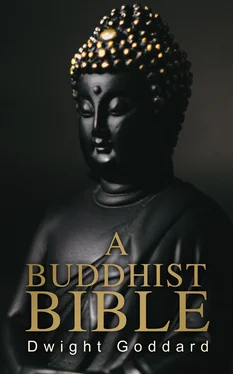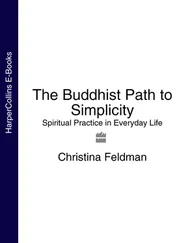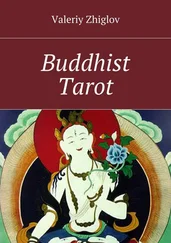ALAYA-VIJNANA: Universal, or Divine Mind, or all-conserving Mind. It is used synonymously with Tathagata-garbha and Noble Wisdom.
ARYA-JNANA: that which transcends knowledge, or Transcendental Intelligence. It is used synonymously with Arya-prajna, but signifies the realisation-aspect of Noble Wisdom.
BODHI: is the wisdom content of Prajna.
KARUNA: is the love or compassion content of Prajna.
JNANA: is the knowledge, or cognition, or thinking content of Prajna.
MANAS: the intuitive mind; the connecting link between Universal Mind and the individual, or conscious, or discriminating, mind.
MANO-VIJNANA: the conscious, perceiving, discriminating, thinking, intellectual, mind.
VIJNANA: the principle of discrimination; the sense-minds.
CITTA: mind in general.
DWIGHT GODDARD.
Thetford, Vermont, U. S. A. 1932 .
HISTORY OF CH’AN BUDDHISM PREVIOUS TO THE TIMES OF HUI-NENG (WEI-LANG)
Table of Contents
The Traffic between India and China in very early times was very considerable in spite of the tremendous difficulties and dangers of the passes over the high Himalayas, the Tibetan deserts and the appalling wastes and tempests of the Southern seas. But in spite of the difficulties intimations of Buddhism began to percolate into China certainly as early as the First Century before the Christian Era and by the First Century after eminent Indian scholars were finding it worth their trouble to make the arduous journey for the sake of the welcome and the honor they received at the Imperial Court and by the literati, so that by the Second Century Buddhist scriptures were being rapidly translated into Chinese.
The Chinese while being notably intellectual were not especially philosophical or religiously minded. They were a practical people and their culture was largely given up to ethics, history, poetry and art. The exuberant imagery, subtle symbolism, erudite philosophy, and deep psychological insight of the Mahayana Buddhist Scriptures came as an intellectual revelation to Chinese scholars and was everywhere received with scholarly enthusiasm. For five hundred years this went on with increasing momentum but. with very little adaptation and change to make it more in line with Chinese mentality and racial habits of thought and national customs. To be sure it had found a certain affinity with Confucian scholarship and ethical idealism, and with Taoist mysticism and naturalistic iconoclasm. All the outstanding Buddhist leaders were Indian born and educated and it was an Indian type of Buddhism that was being pressed upon the Chinese converts; it was Indian philosophy that was being studied and Indian ways of meditation that were being practiced; Buddhism was still a foreign cult. It was not until the Fourth Century that signs of the birth and development of a Chinese type of Buddhism began to be apparent.
When Buddhism reached China it found two main currents of cultural conditions with which it had to contend and make terms, namely, Confucianism and Taoism, neither of which, strictly speaking, were religions. The teachings of Confucius were intellectual and were almost wholly devoted to inculcating habits of ethical idealism among all classes of people. By its presentation of an ideal "superior man" and its emphasis on "propriety" and "obedience" it appealed principally to the educated and official classes and tended to conservatism and the perpetuation of ancient customs and intellectual ideas. It was an admirable culture that resulted in a high type of social ethics and customs second to none even today. It was no mean protagonist for Buddhism to meet, but it had little in common with the rationalistic and disciplinary and self-less ideals of Buddhism. It tended to individual pride of intellect and averice for position and power, while effecting at the same time ideals of a noble and courteous social structure. Buddhism tended toward mind-control; Confucianism tended toward mind culture; Buddhism was revolutionary and iconoclastic; Confucianism was conservative and inert.
As we have said, at first Confucianists welcomed the amazing and abounding philosophy and metaphysics and psychology of Indian Buddhism, but later they came to realise that ultimately it would undermine the foundations of Confucianism. In its distrust of Buddhism during the centuries from the Sixth to the Ninth it inspired wave after wave of nationalistic persecution. It was not until the Eighth and Ninth centuries that it came to appreciate the good qualities of Buddhism and learned not only to tolerate it but also to accept it as supplying those mystical elements which the human heart craves and which in its own teachings were entirely lacking.
The teachings of Taoism on the other hand had many things in common with Buddhism; it can be truly said that Laotsu by his doctrines of Tao and Wu-wei had prepared the way and made ready a welcome for the coming of Buddhism. Nevertheless, there was something in the easy-going laissez-faire naturalism of Laotsu that was diametrically opposed to the austere restraint and discipline of Buddhism. They both loved the quiet of solitude, but the Taoist sage wanted a little congenial company with whom to play checkers and drink wine and quote poetry; while the Buddhist saint sought real solitude that he might be less hindered in his strenuous concentration of mind in the attainment of a self-realisation of ultimate truth.
The doctrines of Tao and Buddha could be harmonised without strain in both their active aspect and their essence of mingled wisdom and beneficence. As the Sanskrit terms of Indian Buddhism slowly gave way to Chinese, the term Tao was freely used for Buddhahood both by itself and in many compounds; in fact at one time it looked as though the term Tao would almost entirely displace the Sanskrit term of Buddha. If a distinction is made in the meaning content of the two terms perhaps the term Buddha came to have a more static significance colored as it was by the conception of the Buddha in samadhi with all its realisation of blissful peace and equanimity; while Tao always carried a significance of dynamic activity. The words Tao and Buddha are often used almost synonymously, but still there remains a shade of distinction between the active and passive sides of reality. One of the early Ch’an Masters said: "Buddha is Tao, Tao is dhyana." The common use of Tao in Buddhist names is also very significant.
To illustrate this free use of Tao by the Ch’an Masters, let me quote a strictly Buddhist production written by Rinsai which is much admired even down to today. It was given to me by my own Master as part of his instruction.
" Buddha-nature is the symbol of purity; Dharma-mind is the symbol of enlightenment; The Tao is the Way of unobstructed truth . In essence these three are truly One, But by themselves they are merely words. The mind of the Tao-man should be pure, enlightened and free ."
Originally Laotsu had a conception of the value of mind-concentration as an intuitive method of arriving at a self-realisation of reality, but in Taoism it had become buried under a burden of self-induced trance and vision and revelation as a guide for the attainment of success and good luck. Nevertheless, there was an underlying similarity or affinity between the conceptions of the value of concentration of mind in both Buddhism and Taoism.
When Buddhism came to China it most decidedly had to make terms with Taoism, for while Confucianism was the cult of the literati, Taoism was the faith of the common people. Taoism was indigenous and while the teachings of Laotsu had been atheistic and sensible, in the course of a thousand years Taoism had taken up into itself the crude animism of a great racial inheritance to make it most decidedly spiritistic and superstitious and geomantic.
Читать дальше












